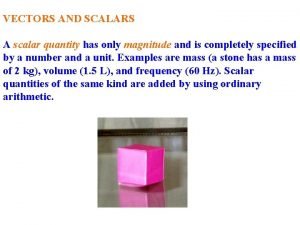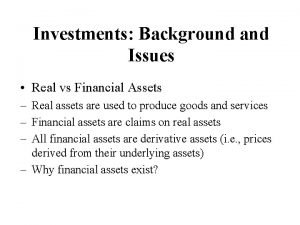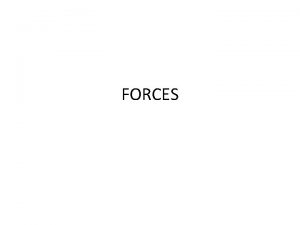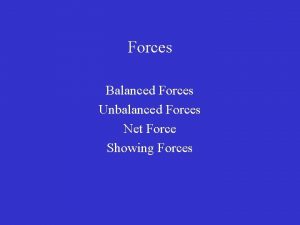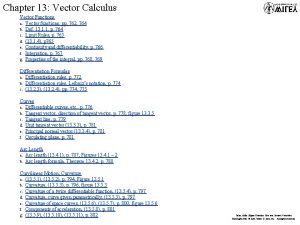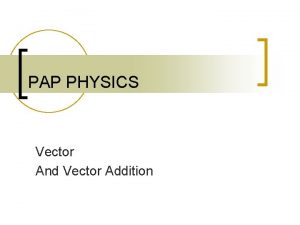Force Force as a Vector Real Forces versus















- Slides: 15

Force • Force as a Vector • Real Forces versus Convenience • The System Outline

Force as a Vector • Forces are vectors (magnitude and direction) • It is typical that multiple forces act on an object simultaneously • In such cases, use vector addition

Fundamental forces 1) Gravity 2) - the force between masses 3) - holds planets and stars together, makes things fall, etc… 2) Electromagnetism 3) 4) - the force between charges - responsible for all familiar “everyday” forces (except gravity) 3) “Weak Nuclear Forces” 4) -changes one ‘flavour’ of quark into another, radioactive decay 4) “Strong Nuclear Forces” 5) - holds atomic nuclei together

Chart: Fundamental forces

Forces of Convenience 1) Tension Force – string, rope, wire… 2) Spring Force – elasticity returns an object to its original shape 3) Normal Force – not that we’re calling other forces abnormal 4) Friction – when one surface moves with respect to another 5) Drag – air resistance, fluid resistance 6) Thrust – what makes a rocket move? These forces aren’t fundamental, but they are a convenient way to visualise the world around us

Tension Force • Elastic (or inelastic) deformation of molecular bonds • Really just the electromagnetic force • Can only pull

Spring Force • Can push or pull • Elastic (or inelastic) deformation of molecular bonds • Really just the electromagnetic force

Normal Force • Normal means orthogonal (orthogonal means at right angles) • Results from compression of molecular bonds • Can only push • Really just the electromagnetic force

If we look closely, the normal force arises from the table being bent : as the table tries to straighten, it pushes back. This is really an elastic force; the table behaves like a spring. At the atomic level, all contact forces are due to electromagnetic forces.

Friction Force • Acts to reduce the relative motion of two surfaces • Results from compression of molecular bonds • Static and Kinetic forms, but still the same concept • Really just the electromagnetic force • Can push or pull

Drag Force • The friction experienced when moving through a fluid • You are currently in a fluid

Thrust Force • Caused by expelled exhaust gasses • Best understood after learning about momentum

Setting up Force Problems • Very important to correctly identify the system you are considering • Imagine a closed surface around that object • All forces in contact with that surface are forces that act on that object • Remember to count long-range forces as well

QQ 34: System Example: Identify all of the forces that are acting on a box moving over a rough surface.

Do for next class: Read: Sections 4. 4, 4. 5 • Suggested problems: 4. 6, 4. 8, 4. 9, 4. 10
 Scalar versus vector
Scalar versus vector Scalar quantity has
Scalar quantity has When your real self and ideal self are similar.
When your real self and ideal self are similar. Apr vs ear
Apr vs ear Financial assets examples
Financial assets examples Real assets versus financial assets
Real assets versus financial assets Directed line segment definition
Directed line segment definition Vector
Vector Vector resolution
Vector resolution What is a position vector?
What is a position vector? Like parallel force
Like parallel force The forces shown above are
The forces shown above are Intermolecular and intramolecular forces
Intermolecular and intramolecular forces Intra vs intermolecular
Intra vs intermolecular Intramolecular forces vs intermolecular forces
Intramolecular forces vs intermolecular forces Contact force
Contact force

